1996 CHEVROLET CAVALIER service
[x] Cancel search: servicePage 278 of 372
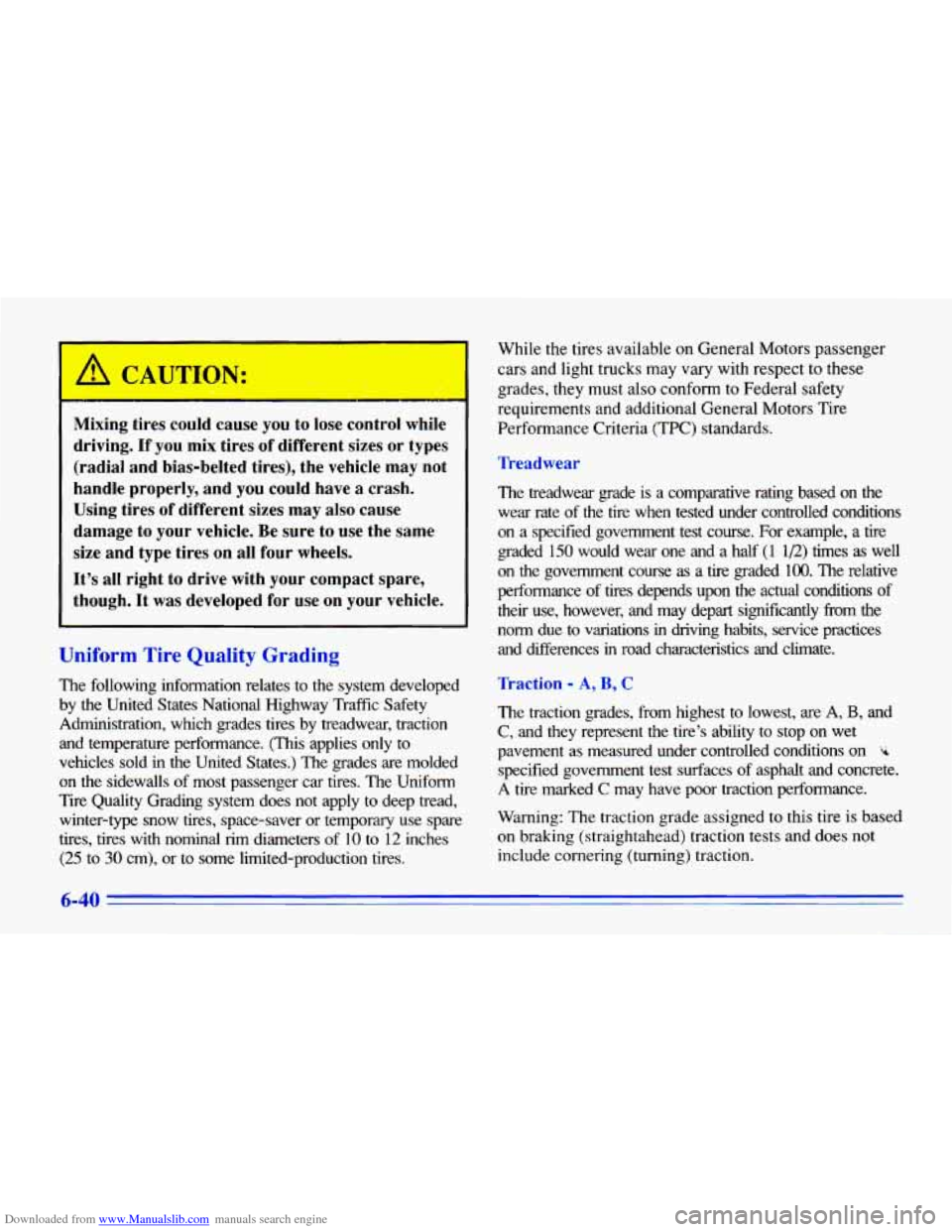
Downloaded from www.Manualslib.com manuals search engine Uniform Tire Quality Grading
The following information relates to the system developed
by the United States National Highway Traffic Safety Administration, which grades tires by treadwear, traction
and temperature performance.
(This applies only to
vehicles sold
in the United States.) The grades are molded
on the sidewalls of most passenger car tires. The Uniform
Tire Quality Grading system does not apply
to deep tread,
A CAUTION:
Mixing tires could cause you to lose control while
driving. If you mix tires of different sizes or types
(radial and bias-belted tires), the vehicle may not
handle properly, and
you could have a crash.
Using tires of different sizes may also cause
damage to your vehicle. Be sure to use the same
size and type tires on all four wheels.
It’s all right to drive with your compact spare,
though. It was developed for use on
your vehicle.
winter-type snow tires, space-saver or temporary use spare
tires, tires with nominal rim diameters of 10 to 12 inches
(25 to 30 cm), or to some limited-production tires. While
the tires available
on General Motors passenger
cars and light trucks may vary with respect
to these
grades, they must also conform
to Federal safety
requirements and additional General Motors Tire
Performance Criteria
(TPC) standards.
Treadwear
The treadwear grade is a comparative rating based on the
wear rate of the tire when tested under controlled conditions
on a specified government test course. For example, a tire
graded 150 would wear one and a half
(1 1/2) times as well
on
the government course as a tire graded 100. The relative
performance
of tires depends upon the actual conditions of
their use, however, and may depart significantly fiom the
norm due
to variations in driving habits, service practices
and differences in road characteristics and climate.
Traction - A, B, C
The traction grades, from highest to lowest, are A, B, and
C, and they represent the tire’s ability to stop on wet
pavement as measured under controlled conditions on
k
specified government test surfaces of asphalt and concrete.
A tire marked C may have poor traction performance.
Warning: The traction grade assigned to this tire is based
on braking (straightahead) traction tests and does not
include cornering (turning) traction.
6-40
Page 288 of 372
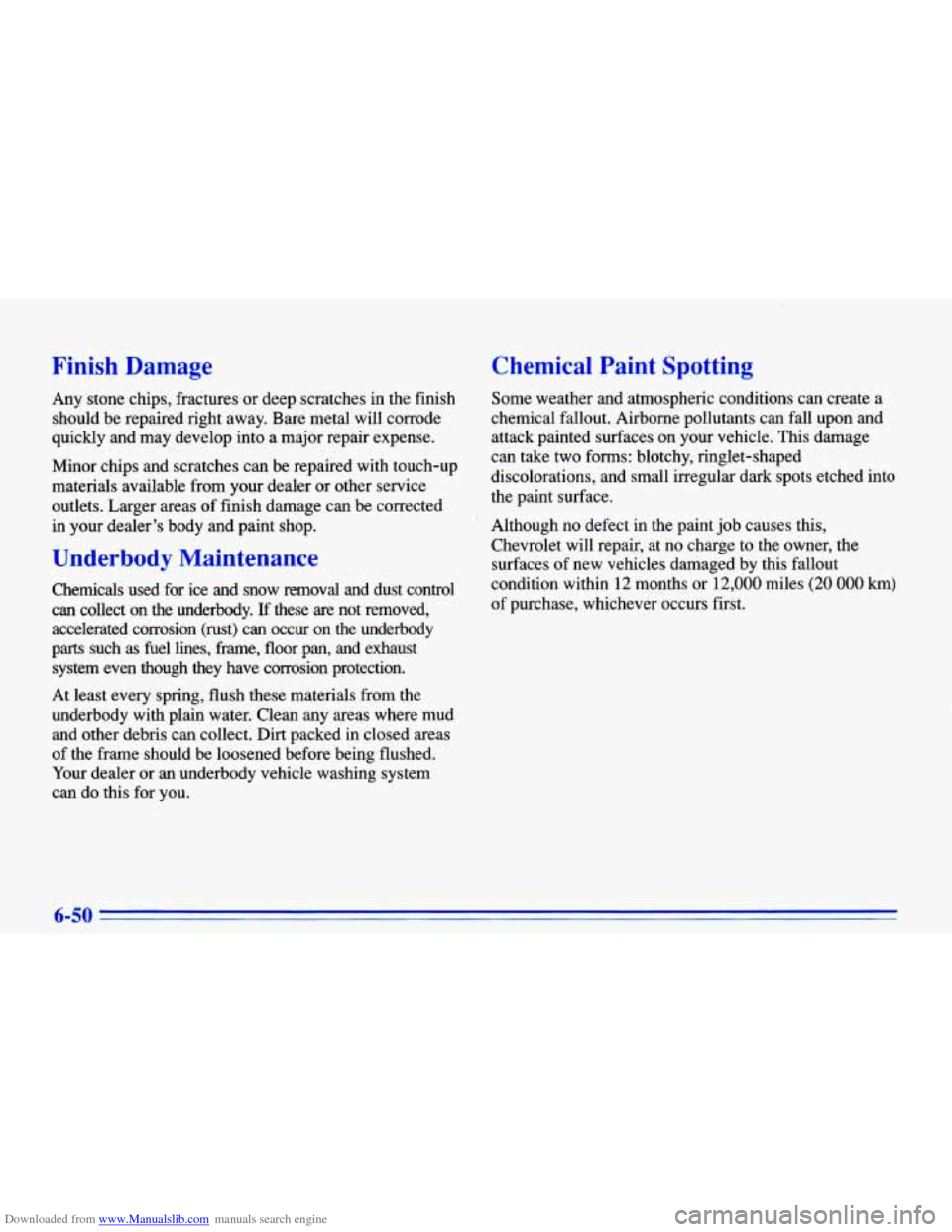
Downloaded from www.Manualslib.com manuals search engine Finish Damage
Any stone chips, fractures or deep scratches in the finish
should be repaired right away. Bare metal will corrode
quickly and may develop into a major repair expense.
Minor chips and scratches can be repaired with touch-up
materials available from your dealer or other service
outlets. Larger areas
of finish damage can be corrected
in your dealer’s body and paint shop.
Underbody Maintenance
Chemicals used for ice and snow removal and dust control
can collect on the underbody.
If these are not removed,
accelerated corrosion (rust) can occur on the underbody
parts such as fuel lines, frame, floor pan, and exhaust
system even though they have corrosion protection.
At least
every spring, flush these materials from the
underbody with plain water. Clean any areas where mud and other debris can collect. Dirt packed in closed areas
of the frame should be loosened before being flushed.
Your dealer
or an underbody vehicle washing system
can do this for you.
Chemical Paint Spotting
Some weather and atmospheric conditions can create a
chemical fallout. Airborne pollutants can fall upon and
attack painted surfaces on your vehicle. This damage
can take two forms: blotchy, ringlet-shaped
discolorations, and small irregular dark spots etched into
the paint surface.
Although
no defect in the paint job causes this,
Chevrolet will repair,
at no charge to the owner, the
surfaces
of new vehicles damaged by this fallout
condition within
12 months or 12,000 miles (20 000 km)
of purchase, whichever occurs first.
6-50
Page 290 of 372
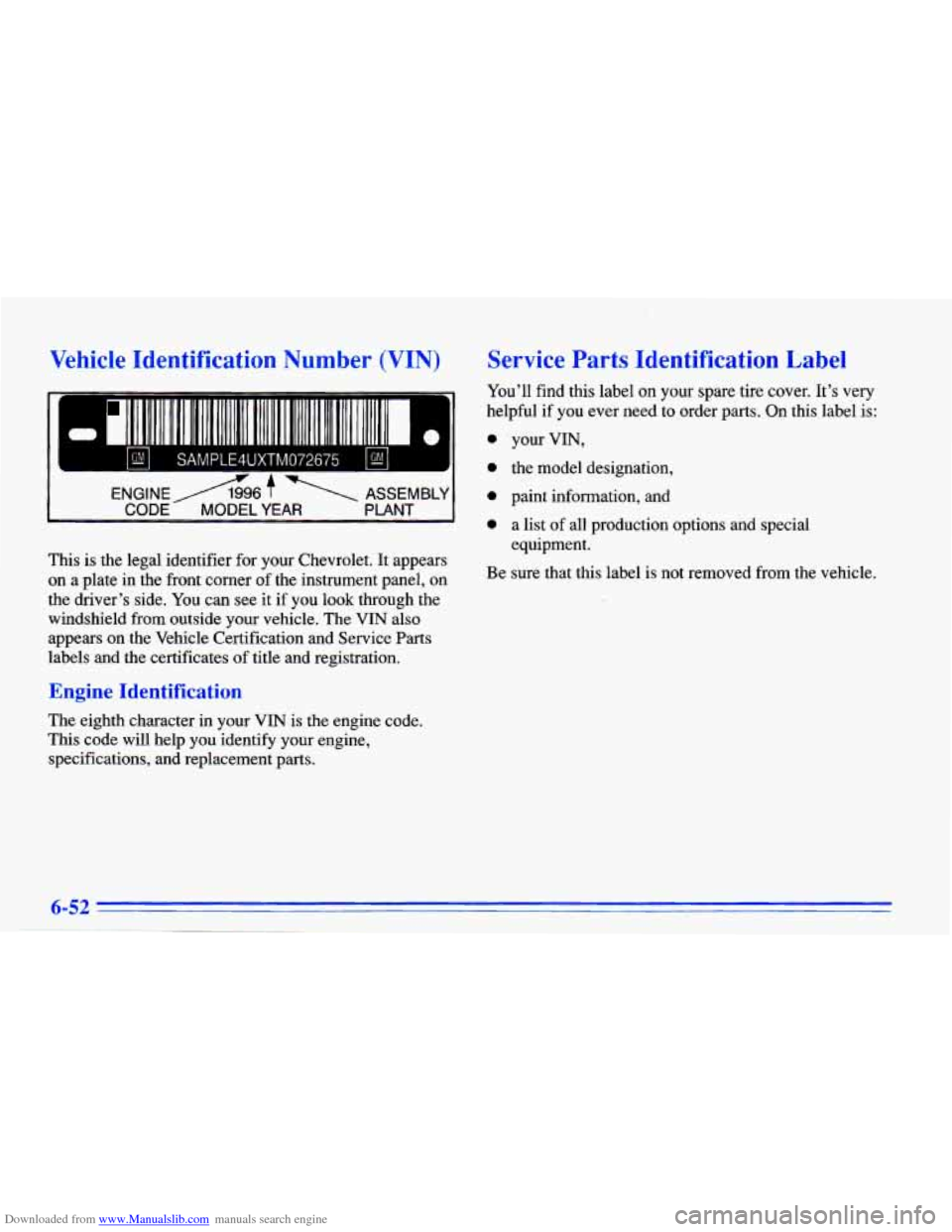
Downloaded from www.Manualslib.com manuals search engine Vehicle Identification Number (VIN)
r
- Dl I1 11111111 1111 111 111111 111 111111II 111111111111 111111111 111 0
SAMPLE4UXTM072675 L A
This is the legal identifier for your Chevrolet. It appears
on a plate
in the front comer of the instrument panel, on
the driver’s side. You can see it if you look through the
windshield from outside your vehicle. The
VIN also
appears on the Vehicle Certification and Service Parts
labels and the certificates of title and registration.
Engine Identification
The eighth character in your VIN is the engine code.
This code will help you identify your engine, specifications, and replacement parts.
Service Parts Identification Label
You’ll find this label on your spare tire cover. It’s very
helpful if you ever need to order parts. On this label
is:
a
0
0
a
your VIN,
the model designation,
paint information, and a list of all production options and special
equipment.
Be sure that this label is not removed from the vehicle.
6-52
Page 296 of 372
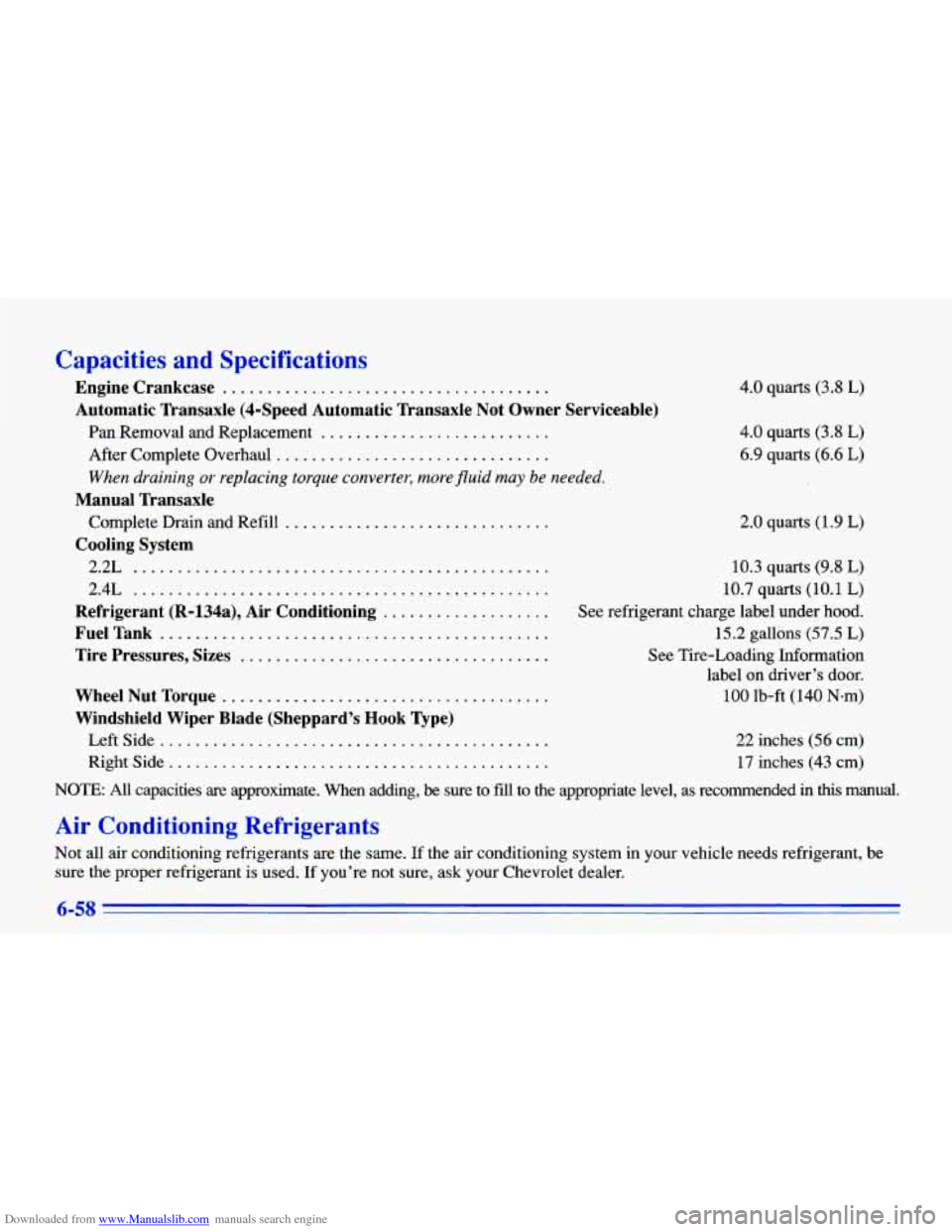
Downloaded from www.Manualslib.com manuals search engine Capacities and Specifications
Engine Crankcase .....................................
Automatic Transaxle (4-Speed Automatic Transaxle Not Owner Serviceable)
Pan Removal and Replacement ..........................
After Complete Overhaul ...............................
When draining or replacing torque converter, more fluid may be needed.
Complete Drain and Refill ..............................
2.2L ...............................................
Manual Transaxle
Cooling System
2.4L ...............................................
Refrigerant (R-l34a), Air Conditioning ...................
FuelTank ............................................
Tire Pressures, Sizes ...................................
WheelNutTorque .....................................
Windshield Wiper Blade (Sheppard’s Hook Type)
LeftSide ............................................
Rightside ...........................................
4.0 quarts (3.8 L)
4.0 quarts (3.8 L)
6.9 quarts (6.6 L)
2.0 quarts (1.9 L)
10.3 quarts (9.8 L)
10.7 quarts (10.1 L)
See refrigerant charge label under hood.
15.2 gallons (57.5 L)
See Tire-Loading Information
label on driver’s door.
100 lb-ft
(140 N-m)
22 inches (56 cm)
17 inches (43 cm)
NOTE: AU capacities are approximate. When adding, be sure to fiil to the appropriate level, as recommended in this manual.
Air Conditioning Refrigerants
Not all air conditioning refrigerants are the same. If the air\
conditioning system in your vehicle needs refrigerant, be sure the proper refrigerant is used. If you’re not sure, ask your Chevrolet dealer.
6-58
Page 299 of 372

Downloaded from www.Manualslib.com manuals search engine 0 Section 7 Maintenance Schedule
I
I
IMPORTANT.
KEEP ENGINE OIL
AT THE PROPER
LEVEL AND CHANGE AS
RECOMMENDED
This section covers the maintenance required for your
Chevrolet. Your vehicle needs these services to retain its
safety, dependability and emission control performance.'
Introduction
Your Vehicle and the Environment
Proper vehicle maintenance not only helps to keep your
vehicle in good working condition, but also helps the
environment. All recommended maintenance procedures
are important. Improper vehicle maintenance can even
affect the quality
of the air we breathe. Improper fluid
levels or the wrong tire inflation can increase the level
of emissions from your vehicle. To help protect our
environment, and to keep your vehicle in
good
condition, please maintain your vehicle properly.
Have you purchased the GM Protection Plan? The Plan
supplements your new vehicle warranties. See your
Warranty and Owner Assistance booklet,
or your
Chevrolet dealer for details.
7-1
Page 300 of 372
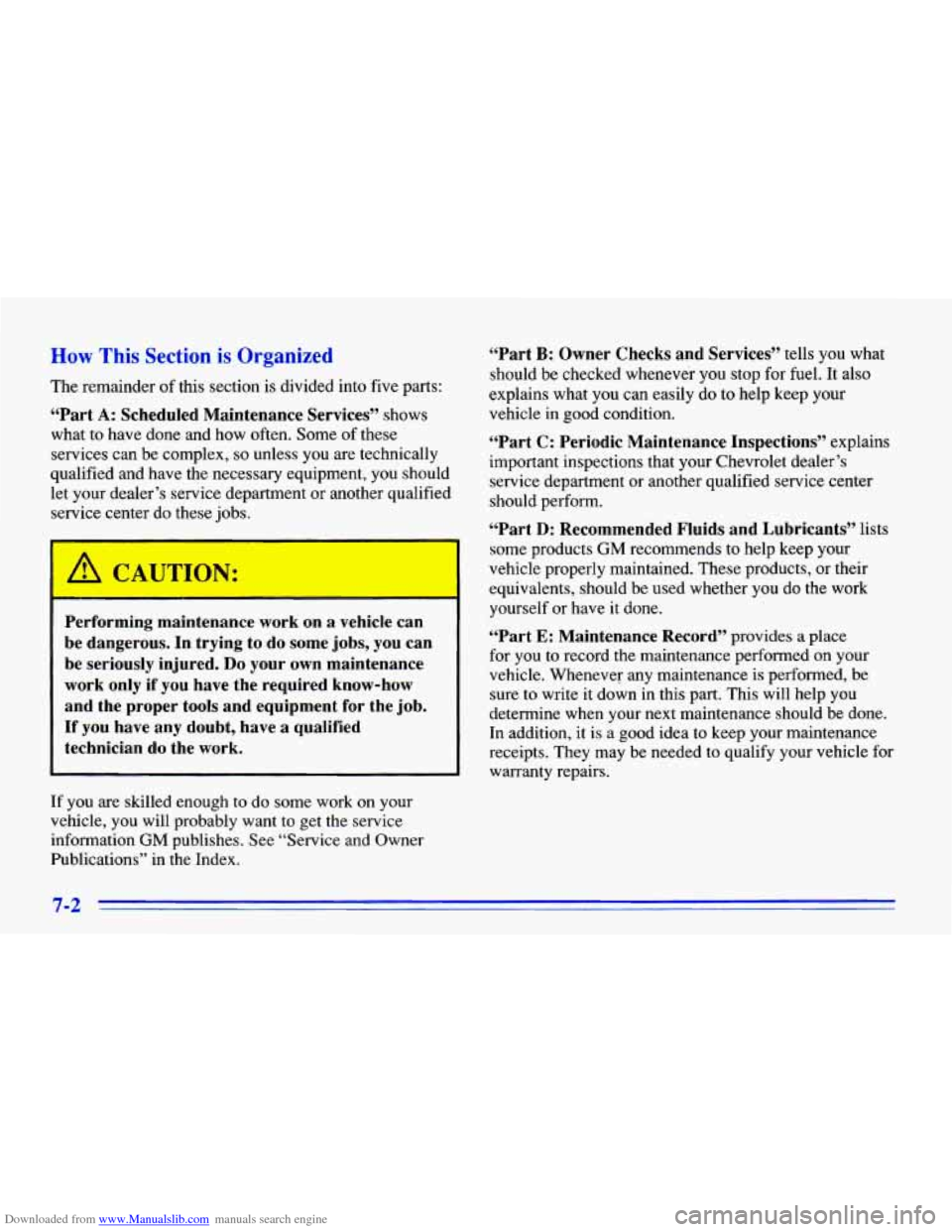
Downloaded from www.Manualslib.com manuals search engine How This Section is Organized
The remainder of this section is divided into five parts:
‘(Part A: Scheduled Maintenance Services” shows
what to have done and how often. Some of these
services can be complex,
so unless you are technically
qualified and have the necessary equipment,
you should
let your dealer’s service department
or another qualified
service center do these jobs.
I
Performing maintenance work on a vehicle can
be dangerous. In trying to do some jobs, you can
be seriously injured.
Do your own maintenance
work only if you have the required know-how
and the proper tools and equipment
for the job.
If you have any doubt, have a qualified
technician
do the work.
If you are skilled enough to do some work on your
vehicle, you will probably want to get the service
information
GM publishes. See “Service and Owner
Publications” in the Index.
“Part B: Owner Checks and Services” tells you what
should be checked whenever
you stop for fuel. It also
explains what you can easily do
to help keep your
vehicle in good condition.
“Part C: Periodic Maintenance Inspections” explains
important inspections that your Chevrolet dealer’s
service department or another qualified service center
should perform.
“Part D: Recommended Fluids and Lubricants” lists
some products
GM recommends to help keep your
vehicle properly maintained. These products, or their
equivalents, should be used whether you do the work
yourself or have it done.
“Part E: Maintenance Record” provides a place
for you to record the maintenance performed
on your
vehicle. Whenever any maintenance is performed, be
sure to write it down in this part. This will help
you
determine when your next maintenance should be done.
In addition, it is a good idea to keep your maintenance
receipts. They may be needed
to qualify your vehicle for
warranty repairs.
Page 301 of 372
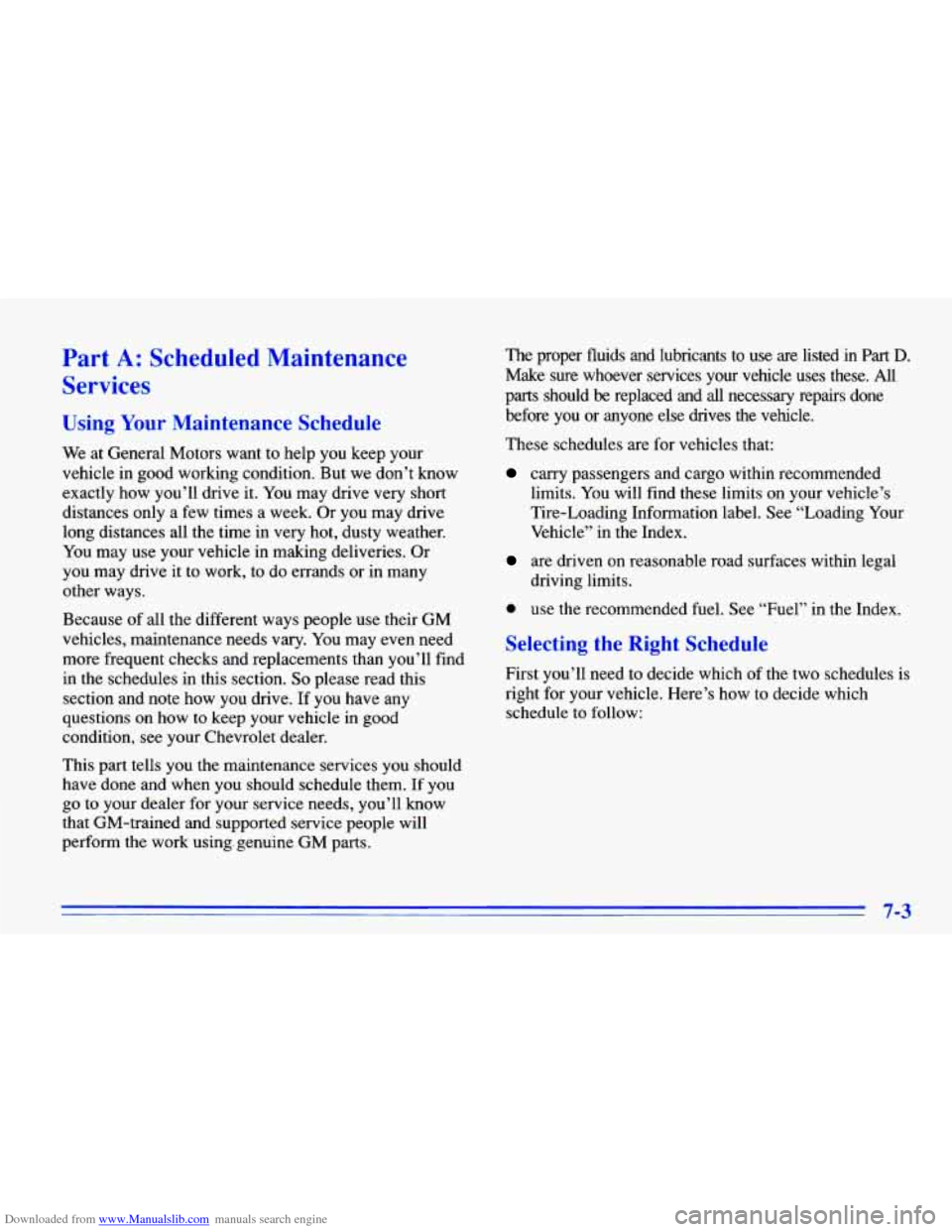
Downloaded from www.Manualslib.com manuals search engine Part A: Scheduled Maintenance
Services
Using Your Maintenance Schedule
We at General Motors want to help you keep your
vehicle in good working condition. But we don’t know
exactly how you’ll drive it. You may drive very short
distances only a few times a week.
Or you may drive
long distances all the time in very hot, dusty weather.
You may use your vehicle
in making deliveries. Or
you may drive it to work, to do errands or in many
other ways.
Because of all the different ways people use their
GM
vehicles, maintenance needs vary. You may even need
more frequent checks and replacements than you’ll find
in the schedules in this section.
So please read this
section and note how you drive. If you have any
questions
on how to keep your vehicle in good
condition, see your Chevrolet dealer.
This
part tells you the maintenance services you should
have done and when you should schedule them. If you
go to your dealer for your service needs, you’ll know
that GM-trained and supported service people will
perform the work using. genuine
GM parts, The proper fluids and lubricants to use are listed
in Part D.
Make sure whoever services your vehicle uses these. All
parts should be replaced and all necessary repairs done
before you or anyone else dnves the vehicle.
These schedules are for vehicles that:
carry passengers and cargo within recommended
limits. You will find these limits on your vehicle’s
Tire-Loading Information label. See “Loading Your
Vehicle” in the Index.
are driven on reasonable road surfaces within legal
driving limits.
0 use the recommended fuel. See “Fuel’’ in the Index.
Selecting the Right Schedule
First you’ll need to decide which of the two schedules is
right for your vehicle. Here’s how to decide which
schedule to follow:
7-3
Page 302 of 372
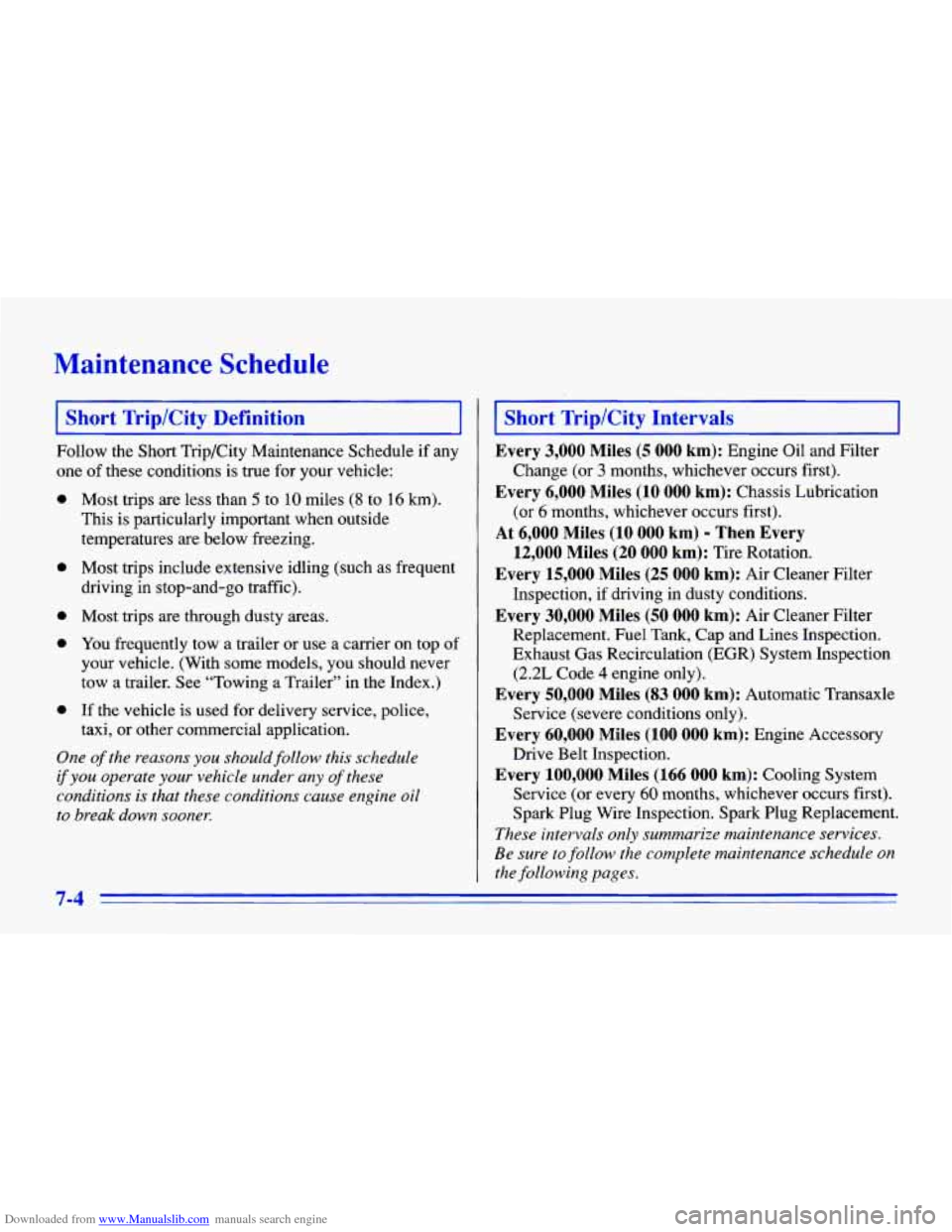
Downloaded from www.Manualslib.com manuals search engine Maintenance Schedule
I Short Trip/City Definition
~~
I
Follow the Short Trip/City Maintenance Schedule if any
one of these conditions is true for your vehicle:
0
0
e
0
e
Most trips are less than 5 to 10 miles (8 to 16 km).
This is particularly important when outside
temperatures are below freezing.
Most trips include extensive idling (such as frequent
driving in stop-and-go traffic).
Most trips
are through dusty areas.
You frequently tow
a trailer or use a carrier on top of
your vehicle. (With some models, you should never
tow a trailer. See “Towing a Trailer” in the Index.)
If the vehicle is used for delivery service, police,
taxi, or other commercial application.
One of the reasons you should follow this schedule
if you operate your vehicle under any of these
conditions is that these conditions cause engine oil
to break down sooner.
Short Trip/City Intervals
Every 3,000 Miles (5 000 km): Engine Oil and Filter
Change (or
3 months, whichever occurs first).
Every 6,000 Miles (10 000 km): Chassis Lubrication
(or
6 months, whichever occurs first).
At 6,000 Miles (10 000 km) - Then Every
12,000 Miles (20 000 km): Tire Rotation.
Every 15,000 Miles (25 000 km): Air Cleaner Filter
Inspection,
if driving in dusty conditions.
Every 30,000 Miles (50 000 km): Air Cleaner Filter
Replacement. Fuel Tank, Cap and Lines Inspection.
Exhaust Gas Recirculation (EGR) System Inspection
(2.2L Code 4 engine only).
Every 50,000 Miles (83 000 km): Automatic Transaxle
Service (severe conditions only).
Every 60,000 Miles (100 000 km): Engine Accessory
Drive Belt Inspection.
Every 100,000 Miles (166 000 km): Cooling System
Service (or every
60 months, whichever occurs first).
Spark Plug Wire Inspection. Spark Plug Replacement.
These intervals only summarize maintenance services.
Be sure to follow the complete maintenance schedule
on
the following pages.
7-4